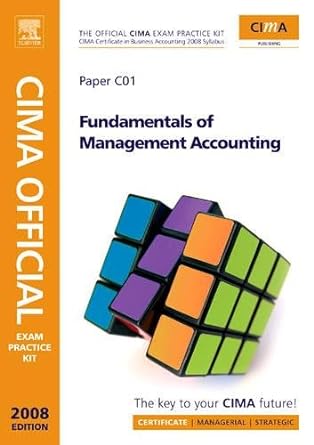Answered step by step
Verified Expert Solution
Question
1 Approved Answer
1.The quick ratio measures a company's ability to pay it's total liabilities. ? a.True, b.False 2.The direct write-off method uses no allowance for the uncollectible
1.The quick ratio measures a company's ability to pay it's total liabilities. ? a.True, b.False 2.The direct write-off method uses no allowance for the uncollectible account. Instead, you wait until you determine that you will never collect from a specific customer. Then you write-off the customer's account receivable. ?a.?True, b.False 3.Selling on credit brings both a benefit and a cost. The benefit is _______________ and the cost is _______________. ?Answer a.Increase revenues and profits by making sales to a wider range of customers; some customers do not pay. b.Increase revenues and profits by making sales to a wider range of customers; increase in salary expense for the salesperson c.Increase revenues and profits by making sales to a wider range of customers; increase in cost to purchase inventory d.Increase in profits; decrease expenses 4.In many situations, the ethical choice is obvious. In other cases, the choices are more difficult. Consider the situation below: John Johnson's company owes $75,000 to US Bank. The loan agreement requires Johnson's company to maintain a current ratio of 1.50 or higher. At present, the company's current ratio is 1.35. At this level, Johnson is in violation of the loan agreement. The company can increase the current ratio to 1.55 by paying off some current liabilities. This is not ethical because Johnson is trying to defraud the bank. True False 5.There is another way to account for uncollectible receivables that is primarily used by large, public companies called the direct write-off method. a.True, b.False 6.Which of the following is NOT a purpose of internal control? ?Answer a.To encourage employees to follow company policy b.To promote operational efficiency c.To ensure accurate, reliable accounting records d.To ensure that a company pays its bills 7.The collection period which indicates how many days it takes to collect the average level of receivables is called: ? a.quick ratio b.current ratio c.sales collection turnover d.days' sales in receivables 8.Accounts receivables appear: ?Answer a.in the liabilities section of the Balance Sheet b.under expenses on the Income Statement c.in the current assets section of the Balance Sheet d.none of the above 9.Which method of estimating uncollectible receivables focuses on Uncollectible-account expense for the balance sheet? ? a.Net-realizable-value approach b.Aging-of-accounts approach c.Percent-of-sales approach d.All of the above 10.The Sarbanes-Oxley Act was passed by Congress to ?Answer a.Establish and formulate generally accepted accounting principles b.Promote corporate governance and to oversee the auditors of public companies c.Assist companies in how to defraud the SEC and investors d.None of the above 11.Ethics in business (accounting) is really about analyzing right from wrong. Most companies have a code of ethics to encourage employees to behave ethicially. Owners and managers must also set a high ethical tone in the organization as well. ?a.True , b.False 12.According to a Sarbanes Oxley provision, accounting firms may not audit a public client and also provide certain consulting services for the same client. ?a.?True, b. False 13.The process of reviewing the financial statements of an entity by an independent third party with the objective of expressing an opinion about the fairness of the presentation of the entity's financial position, results of operations, and changes in financial position is called a(n) ?Answer a.trial balance b.cost accounting c.adjusting entries d.audit 14.Internal controls are so important in the US that the US Congress passed a law that requires all companies to maintain a system of internal controls. ?a.True, b. False 15.Receivables are reported on the Balance Sheet at their net realizable value which means: ? a.less the full amount of the receivables because we cannot collect from some customers (total receivables minus the allowance for uncollectibles) b.the full amount of the receivables plus interest c.both (a) and (b) d.none of the above 16.Why is it important for receivables accounting and handling cash to be separated? ?Answer a.It's not important to separate the duties b.One person could take the cash and then write it off the account as uncollectible c.One person can handle both duties, you just have to make sure you trust them d.None of the above 17.There are two major types of receivables: ?Answer a.control and accounts receivable b.notes and trade receivable c.subsidiary and notes receivable d.none of the above 18.A bank reconciliation: ? a.is considered a control over cash b.reconciles on a specific date the differences between cash on the company's books and cash according to the bank's records c.both (a) and (b) d.none of the above 19.Which method of estimating uncollectible receivables is called the income-statement approach because it focuses on the amount of expense? ?Answer a.Net-realizable-value approach b.Aging-of-accounts approach c.Percent-of-sales approach d.All of the above 20.Cash is the most liquid asset because it is the medium of exchange. Keeping cash in a bank account helps control cash because banks have established practices for safeguarding customer's money. ?Answer?a.True b.False
Step by Step Solution
There are 3 Steps involved in it
Step: 1

Get Instant Access to Expert-Tailored Solutions
See step-by-step solutions with expert insights and AI powered tools for academic success
Step: 2

Step: 3

Ace Your Homework with AI
Get the answers you need in no time with our AI-driven, step-by-step assistance
Get Started


